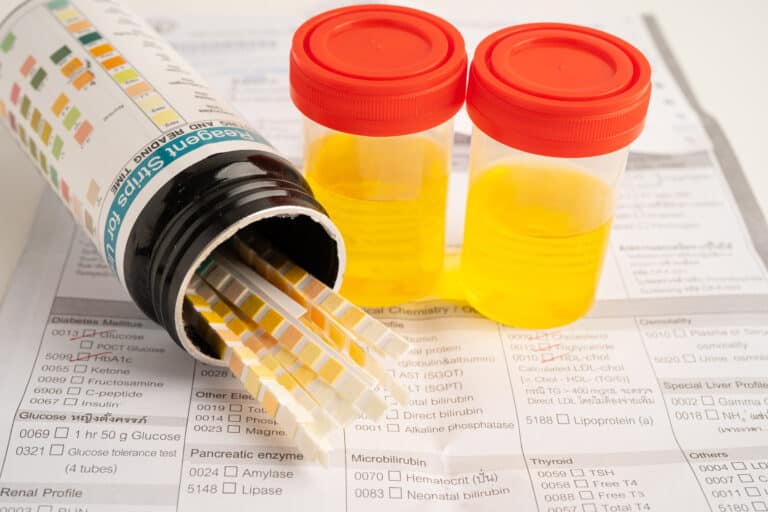Methamphetamine, commonly known as meth, is a powerful stimulant that affects the central nervous system. While it has some limited legal applications in the treatment of ADHD and certain types of obesity, its high potential for abuse has led to widespread illicit usage. The drug’s ability to release an intense surge of dopamine in the brain not only contributes to its addictive qualities but also heightens the risk of developing meth-induced psychosis. This severe condition can dramatically alter perception, thoughts, and behavior. This form of psychosis, prevalent among chronic meth users, underscores the critical need for awareness and intervention strategies to address and mitigate the devastating impacts of meth abuse.
What is Methamphetamine?
Methamphetamine is a synthetic chemical closely related to amphetamine but with more potent effects on the brain and central nervous system. It usually appears as a white, odorless, bitter-tasting crystalline powder that easily dissolves in water or alcohol. Commonly known as ice, crystal, or glass, meth can be smoked, snorted, injected, or orally ingested. The versatility in its methods of use contributes to its widespread popularity and enhances its danger, making it highly accessible and more prone to abuse. This accessibility significantly complicates efforts to combat the meth epidemic, highlighting the urgent need for comprehensive drug education and effective treatment programs.
Understanding Psychosis
Psychosis is a mental disorder characterized by a disconnection from reality. This can manifest as hallucinations, delusions, and severely disordered thinking and behavior. It disrupts a person’s thoughts and perceptions, making it difficult to recognize what is real and what isn’t. The condition not only impacts the affected individual’s ability to function in daily life but also places a significant strain on relationships and professional responsibilities. Early intervention and treatment are crucial for managing symptoms effectively and improving quality of life, emphasizing the importance of understanding and recognizing the early signs of psychosis.
Meth-Induced Psychosis Explained
Meth-induced psychosis specifically refers to psychosis triggered by the abuse of methamphetamine. Symptoms often include paranoid delusions, auditory and visual hallucinations, and erratic behavior. These symptoms can appear during or after meth use, and their severity usually correlates with the frequency and amount of meth consumed. This direct correlation underscores the profound dangers associated with escalating meth use, which not only deteriorates mental health but also heightens the risk of long-term psychological damage. Recognizing these symptoms early is crucial for prompt intervention, which can significantly alter the trajectory of recovery and reduce the potential for lasting harm.
Causes of Meth-Induced Psychosis
Biologically, meth alters brain chemistry, particularly impacting the dopamine system, which is crucial for the brain’s reward, motivation, and pleasure centers. Environmentally, factors such as stress, lack of sleep, and existing mental health issues can exacerbate the onset of psychosis. These changes can create a vicious cycle where the altered brain function makes users more susceptible to environmental stressors, thereby increasing their reliance on the drug. Understanding this interplay between biological changes and environmental factors is critical to developing targeted interventions that address both aspects of addiction and its psychiatric consequences.
Risk Factors
Individuals with a history of mental illness, frequent meth users, and those who consume high doses are at a higher risk. The risk increases with the duration and intensity of meth use. This escalation in risk highlights the critical need for specialized care and preventive measures tailored to these vulnerable groups. By understanding and addressing the unique challenges faced by individuals at greater risk, healthcare providers can better implement strategies that prevent the onset of severe conditions like meth-induced psychosis and improve outcomes for those already affected.
Diagnosis of Meth-Induced Psychosis
Diagnosing this condition involves a comprehensive medical and psychological evaluation to rule out other causes of psychosis. Blood tests, brain imaging, and detailed discussions about drug use history are typically part of the assessment. This thorough diagnostic approach ensures that treatment is accurately tailored to the individual’s specific needs, distinguishing meth-induced symptoms from those of other psychiatric or neurological disorders. Such precision is crucial for effective treatment, guiding the recovery process, and optimizing patient outcomes.
Treatment Options
Immediate treatment often requires hospitalization to manage acute symptoms safely. Long-term treatment involves a combination of medication, counseling, and support groups. Antipsychotic drugs and cognitive-behavioral therapies are common approaches. This dual strategy of addressing both the immediate and ongoing needs of the patient is essential for managing meth-induced psychosis effectively. Hospitalization provides a safe environment for crisis intervention, while ongoing therapies and support systems help sustain recovery, prevent relapse, and promote mental health resilience over time.
Rehabilitation and Recovery
Professional rehabilitation programs are crucial for recovery. These programs offer structured treatment environments that focus on detoxification, therapy, and relapse prevention strategies. Such structured settings are vital as they provide the necessary support and resources tailored to address the complexities of meth-induced psychosis. By fostering a controlled environment where individuals can detox safely and learn coping mechanisms, these programs significantly enhance the likelihood of successful long-term recovery and help individuals rebuild a stable and healthy lifestyle.
Preventive Measures
Prevention focuses on education about the risks of meth use, early intervention programs, and community outreach to discourage drug abuse. By raising awareness and providing accurate information through these channels, communities can better equip individuals with the knowledge to make informed decisions and identify early signs of substance misuse. Such preventative measures are essential in reducing the prevalence of meth-related issues, including meth-induced psychosis, ultimately fostering a healthier, more informed society.
Life After Recovery
Post-recovery life involves continued adherence to treatment plans, regular check-ins with mental health professionals, and possibly lifelong management of mental health. This ongoing engagement is crucial for maintaining the gains achieved during treatment and preventing relapse. By staying connected with healthcare providers and maintaining a proactive approach to mental health, individuals can navigate the challenges of recovery with greater resilience and support, ensuring a sustainable return to daily life and well-being.
Conclusion
In conclusion, while meth-induced psychosis presents a severe challenge, it remains a treatable condition. Early recognition of symptoms and timely intervention are crucial to successful recovery. For those experiencing or witnessing the signs of meth-induced psychosis, it is essential to seek professional help immediately. Engaging with healthcare professionals who specialize in addiction and mental health can provide the necessary support and treatment strategies to overcome this condition. Don’t hesitate to ask for help—taking that first step could be the turning point towards reclaiming a healthy and fulfilling life. If you or someone you know is struggling, contact us today to learn more about the resources and support available for recovery from meth-induced psychosis.






